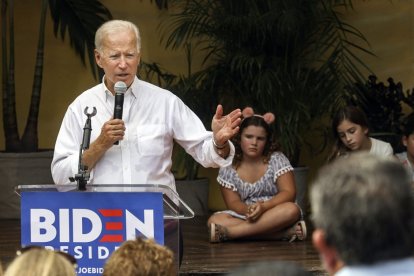Hispanics and blacks are leaving the left faster than most other Americans
Progressivism is no longer seducing Americans, according to a study.

Joe Biden en un acto electoral para ganar el voto hispano / Cordon Press.
"The left is losing the battle for the minds of the American electorate." This is the main conclusion of a study conducted by Morning Consult. The company collects ratings from at least 750,000 registered voters since 2017.
Leftism in demise
In 2017, 9% of the electorate declared themselves "very liberal", to which was added another 15% who declared themselves "liberal", and 10% who define themselves as "moderately liberal". In total, 34% saw themselves as liberal.
In 2022, the percentage of voters who say they are "very liberal" remains at 9%, but "liberals" have fallen to 11% and those who are moderately liberal, to 7%. In total, only 27% consider themselves to be on the left, 7 points less than just five years ago.
Conservatives remain strong
The same is not true for those who declare themselves conservatives. Those who say they are moderate have gone from 11% to 9%. Those who define themselves as conservative remain, in 2022 as in 2017, 16% of the American population. Meanwhile, the "very conservative" were 11% of voters five years ago, and in 2022 they are 14%. Thus, those who define themselves on the right were 38% in 2017 (four points more than leftists), and now they are 39% (12 points more than leftists).
If there are fewer leftists, and the proportion of conservatives is maintained, which political position is increasing? On the one hand, the number of "moderates", or centrists, is increasing, with 28% of voters, up from 24% five years ago. And, on the other hand, 3% was not defined in 2017, and now it is 7%.
At least since the massive use of the Internet, one of the problems blamed on politics in the United States is polarization. The Morning Consult poll seems to indicate that this problem has been mitigated: The number of progressives is decreasing and the number of conservatives is not increasing, but the number of moderates is increasing.
In the younger cohort, ages 18 to 34, the percentage of those who define themselves as leftists "has dropped more than the other age groups," the report says. From 47% to 34%. This left dropout rate is followed by the following age cohorts, so that it is less pronounced the older the age: 35-44, 45-64 and over 65.
Blacks and Hispanics
But perhaps most significant is the evolution of the black and Hispanic vote. According to the study, "for every age group, black and Hispanic voters would be more likely to abandon left-wing ideology than white voters," the study says.
Some 45% of white voters are conservative, and 25% leftist, with another 26% moderate. Blacks and Hispanics are further to the left, but they are leaving that position at a very high rate for only five years.
Hispanics are more conservative
Forty-nine percent of blacks used to define themselves as leftists, and now it is only 34%. As far as the Hispanic vote is concerned, half was left-leaning in 2017, and today it is 34%. What is interesting is that in the case of Hispanics there has been an increase in conservatives: from 25% to 29%. The increase in those who define themselves as very conservative among Hispanics with a graduate degree is striking. They are the largest group, along with the "very progressive".
These changes may have electoral effects. Among other findings of the study, as Americans define themselves less as leftists, they identify the Democratic Party with the left more frequently. Among those who have increased the most in their identification of Democrats with the left are Hispanics: they were 65% five years ago, and now they are 75%.
"The Achilles heel of the Democratic Party"
Ruy Teixeira is a member of one of the strongest moderate currents of the Democratic Party: the "liberal nationalists". The Liberal Patriot is their unofficial blog. Teixeira writes in that blog an article in which he asks "What's going on with Hispanic working class voters?".
Teixeira defines them as "the Achilles heel of the Democratic Party". He cites two studies (one yet to be published) that come to the same conclusion, "There was a 16-point margin swing in favor of the GOP" in the 2020 election. Then, when asked which party represents the interests of "people like you," 51% of Hispanics said the Democratic Party, but 48% said it was the Republican Party, so the two are very close.
Moreover, he acknowledges that this trend has deepened in recent years, citing, among other considerations, the Biden among Hispanics. The latest data show that 55% reject his performance, while 36% approve it. Moreover, "In the latest Economist/YouGov poll, Hispanic voters give Republicans a 9 point lead over Democrats on the generic Congressional ballot."
The Democratic Party is less responsive to their interests
Teixeira points to two issues. On the one hand, the culture fights led by the Democratic Party drive away conservative and moderate Hispanic voters. On the other hand, Hispanics are very concerned about economic issues, and the Bidenomics is making it hard for Democrats to gain new votes.
Ileana Ros-Lehtien (R) is the first Hispanic woman to be a member of the House of Representatives, an institution she has served continuously for 30 years (1989-2019). In a recent article the former congresswoman also offers her thoughts on what is driving Hispanics away from the Democratic Party.
On the one hand, they like to be in control of their children's education. The Democratic Party, which is "overly beholden to teacher unions," cannot offer that to Hispanics. The same is true for healthcare. Hispanics increasingly want to choose their own health coverage. A third factor is safety. They value it highly, and are not convinced by the policies of defunding the police, which have been carried out in the past few years ( or among other cities).
RECOMMENDATION





















